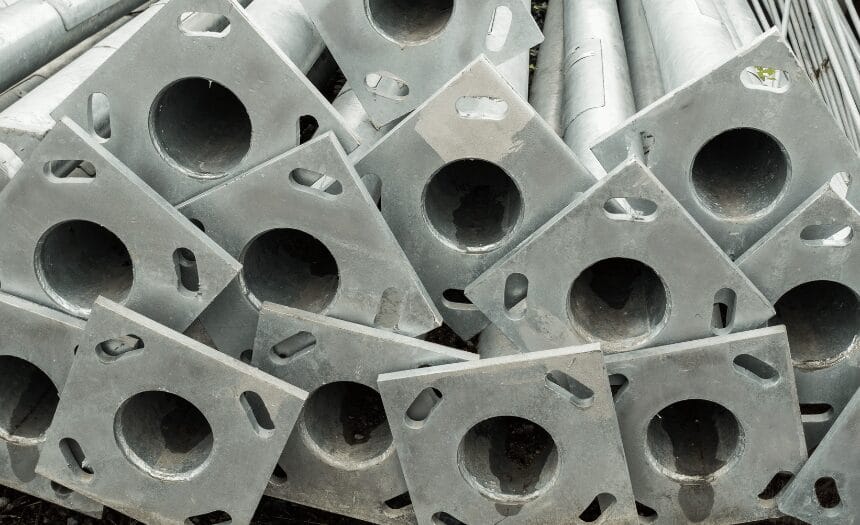
Steel base plates are fundamental elements employed in various manufacturing processes. These flat, rectangular plates, crafted from superior-quality steel, act as the bedrock or support for an array of structures and machinery. Industries such as construction, engineering, and manufacturing frequently utilize these plates.
Primarily, steel base plates are used to stabilize and distribute the weight of hefty machinery, equipment, and structures uniformly. They are typically bolted or welded to the ground or another surface to guarantee a secure foundation. The thickness of steel base plates is contingent on the specific application and load requirements, and they are available in various standard dimensions to accommodate diverse needs.
Kloeckner Metals is a full-line steel supplier and service center. Download our structural steel spec sheet to see in greater detail what Kloeckner Metals routinely stocks.
At Kloeckner Metals, we provide an extensive range of steel base plates that comply with industry standards and requirements. Our expert team can guide you in selecting the appropriate base plates for your specific application, ensuring optimal performance and durability.
Steel base plates are flat, rectangular plates utilized as a foundation or support for various structures and equipment. Crafted from high-quality steel, they offer exceptional strength and durability.
One of the primary reasons steel base plates are used is their capacity to provide a stable and secure base for heavy structures and equipment. Whether it’s a large industrial machine, a steel column, or a structural support, steel base plates ensure that the load is evenly distributed, and the structure remains stable.
Steel base plates are commonly employed in construction projects such as building foundations, bridges, and industrial structures. Additionally, they are utilized in the manufacturing industry for equipment support, including conveyor systems, machinery, and storage racks.
These plates are favored for their ability to bear heavy loads and resist deformation. The high strength of steel allows the base plates to support the weight without compromising the structural integrity. Additionally, steel base plates offer excellent corrosion resistance, making them suitable for both indoor and outdoor applications.
Steel base plates are versatile components serving various purposes in different industries. Here are some common applications of steel base plates:
Structural Support in Construction Projects: Steel base plates provide stability and support for structural columns and beams in construction projects. They help distribute the load and anchor the structure to the foundation, ensuring its strength and durability.
Foundation Reinforcement for Machinery and Equipment: Steel base plates are often used to reinforce the foundation of heavy machinery and equipment. By providing a sturdy and secure mounting surface, they help prevent movement, vibration, and potential damage.
Mounting Surface for Magnetic Stands and Fixtures: Steel base plates are commonly used as a reliable mounting surface for magnetic stands and fixtures in industrial settings. The magnetic properties of the steel make it an ideal choice for securely attaching and positioning equipment.
Base Plates in Wind Towers: In the renewable energy industry, steel base plates play a crucial role in wind tower construction. They provide a stable foundation for wind turbines, ensuring their safe and efficient operation.

For lighter loads and smaller base plates, a thickness of 1/4 inch to 1/2 inch may be sufficient. However, for heavier loads and larger base plates, a thickness of 1/2 inch to 1 inch or more may be necessary to ensure adequate support.
Typically, steel base plates come in square or rectangular shapes. The standard dimensions for square steel base plates range from 4 inches to 36 inches, with thicknesses ranging from 1/4 inch to 1 inch. Rectangular steel base plates usually have a length-to-width ratio of 3:1, and the standard dimensions vary from 6 inches by 8 inches to 36 inches by 48 inches.

Understanding the weight of steel base plates is crucial for any construction or engineering project. The weight of a typical steel base plate can vary depending on its size, thickness, and specific material composition.
The weight of a steel base plate is measured in pounds per square foot (psf) or pounds per square inch (psi). The exact weight will depend on the plate’s dimensions, which include length, width, and thickness.
For instance, a standard 1-inch thick steel base plate with dimensions of 12 inches by 12 inches will typically weigh approximately 40 pounds per square foot. Similarly, a thicker plate, such as a 2-inch thick base plate, will have a higher weight per square foot.
It is important to note that the weight of a steel base plate can also be influenced by any additional features or modifications, such as holes or cutouts, which may reduce the overall weight.
Steel base plates are a versatile and essential component used in various industries. Their durability, strength, and stability make them an ideal choice for a wide range of applications. Let’s explore some of the industries that heavily rely on steel base plates:
Steel base plates are extensively used in the construction industry for structural support. They provide a solid foundation for buildings, bridges, and other infrastructure projects. Steel base plates ensure stability and help distribute the load effectively.
In the manufacturing sector, steel base plates play a vital role in supporting heavy machinery and equipment. They provide a secure platform for machines, ensuring stability and minimizing vibrations during operation.
Steel base plates are used in the transportation industry for various applications. They are commonly found in the fabrication of trailers, truck bodies, and railcar components. Steel base plates provide strength and stability, ensuring the safe transportation of goods and materials.
In the energy sector, steel base plates are utilized in power plants, substations, and renewable energy projects. They provide a sturdy base for equipment, such as generators, transformers, turbines, and solar panels.
Steel base plates are crucial in the oil and gas industry. They are used in offshore platforms, pipelines, and refineries. Steel base plates offer excellent corrosion resistance and can withstand harsh environmental conditions.
Steel base plates find applications in various industrial manufacturing processes. They are used in the fabrication of machine frames, workbenches, and assembly lines. Steel base plates provide stability and support for precise manufacturing operations.
At Kloeckner Metals, we understand the importance of using high-quality materials to ensure the durability and reliability of our products. When it comes to steel base plates, we utilize a range of grades that offer exceptional strength and performance. Our selection includes:
At Kloeckner Metals, we source our steel base plates from reputable mills and manufacturers, ensuring that they meet the highest quality standards.
There are several plate processing options available to ensure steel base plates meet your specific needs and requirements. One key aspect of plate processing is the variety of hole sizes and patterns that can be incorporated into the base plates. This allows for easy installation and compatibility with different structural designs.
Whether you need a single large hole or multiple smaller holes, the flexibility of plate processing enables us to create base plates that perfectly match your project specifications. This not only saves time during installation but also ensures a secure and precise fit.
Another important consideration is the choice of thicknesses for steel base plates. Different applications require different load-bearing capacities, and our plate processing capabilities allow us to accommodate these specific load requirements. Whether you need a thicker base plate for heavy-duty machinery or a thinner one for lighter structures, we can provide the right solution.
Steel base plates can also undergo cutting, welding, and bending processes to achieve the desired shape or dimensions. Cutting allows for precise sizing, while welding ensures a strong and seamless connection between different parts. Bending, on the other hand, enables the base plates to conform to curved surfaces or specific angles.
Surface treatments, such as galvanizing or powder coating, can also be applied to steel base plates. These treatments provide an added layer of protection against corrosion, extending the lifespan of the base plates and enhancing their durability in harsh environments.
Base plates are an essential component in various industries, including construction and engineering. They provide a stable and secure foundation for structures, equipment, and machinery. At Kloeckner Metals, we offer high-quality steel base plates that come with several benefits.
In the market for steel for base plates? Kloeckner Metals is a full-line steel supplier and service center. We combine a national footprint with the latest fabrication and processing technologies and the most innovative customer service solutions.

Metal fabrication is a critical process that transforms raw metal...
The solar industry has undergone a significant transformation by incorporating...
The unprecedented pace of solar growth is challenging and reforming...

X
The Kloeckner Metals website uses modern technologies. Unfortunately, your browser doesn't support those technologies.
Download the latest version of one of these browsers to experience the site: